I’ve been driving on French roads for many years—first as a tourist, and now as a resident of this country I love and explore deeply with my family.
On diegoenfrance.com, I share everything I’ve learned along the way so your experience can be just as good—or even better.
What is driving in France really like?
In France, drivers are at the center of a system designed for enjoyment. Speed limits must be respected, tolls are common, and carrying a safety vest, warning triangle, and wearing seat belts is mandatory. Roads are well maintained, signs are clear, foreign licenses are accepted, and international insurance is recommended. Traffic varies by region and season
In this article, you’ll find:
- Everything you need to know to drive confidently in France: rules, signs, tolls, parking, and more.
- Practical tips and real advice from years of driving through villages, highways, and scenic backroads.
- Perfect for you—planning a family trip, seeking freedom, and wanting to discover France at your own pace, hassle-free.
The Most Complete Local Guide to French Driving Rules and Touring France by Car
Are you coming to France as a tourist and plan to drive? You do very well. I always recommend exploring France by car for a more complete experience and to immerse yourself in the culture and especially the Art de Vivre à la Française.
Practical Tips for Driving in France
The tips I will share with you are real advice from years of experience, designed specifically for those who wish to drive in France and transform this activity into an unparalleled experience.
From avoiding common mishaps to discovering hidden gems accessible only by road, what I offer you is a veritable treasure trove of insider information.
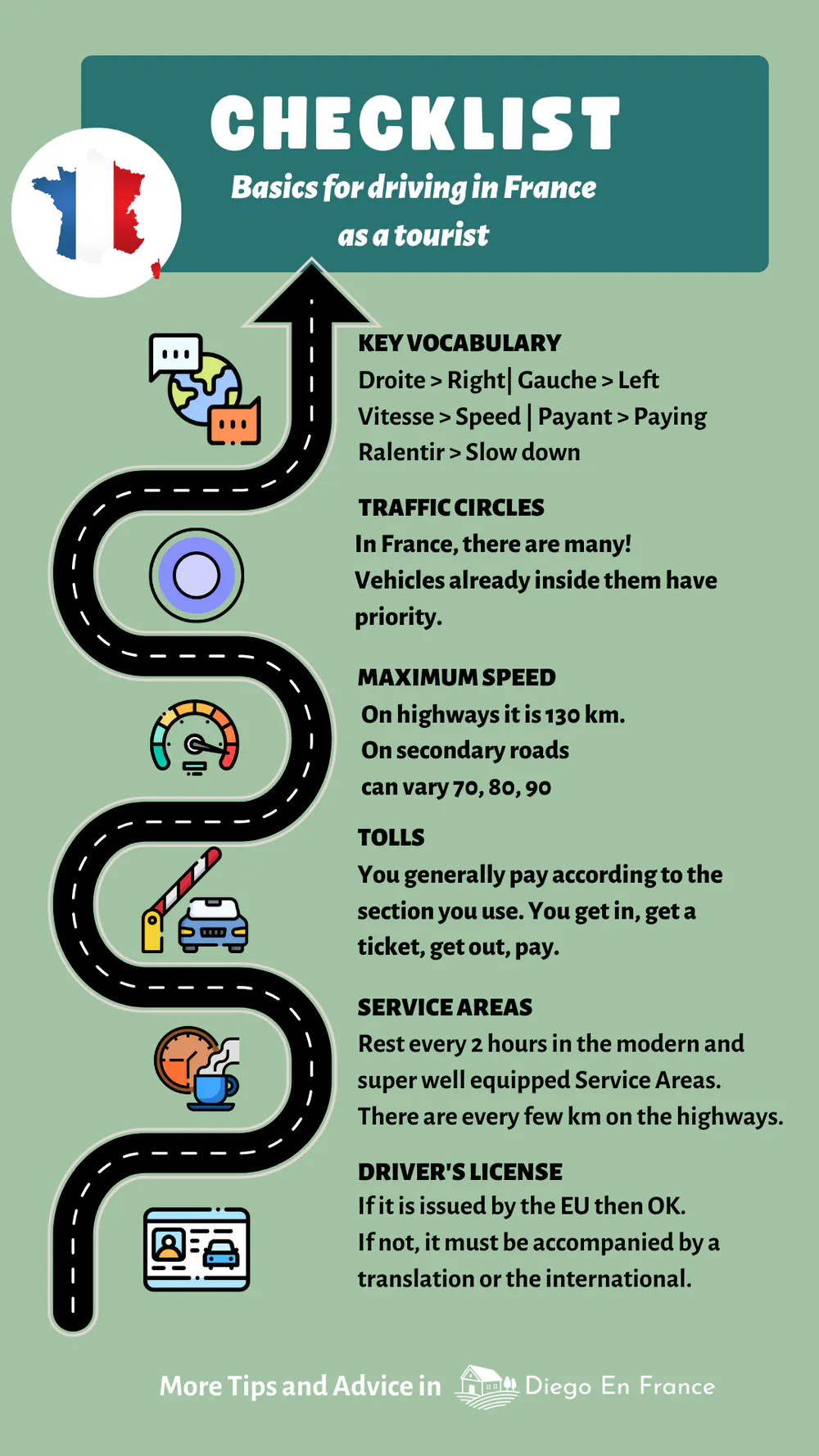
How to Drive Safely and Stress-Free in France
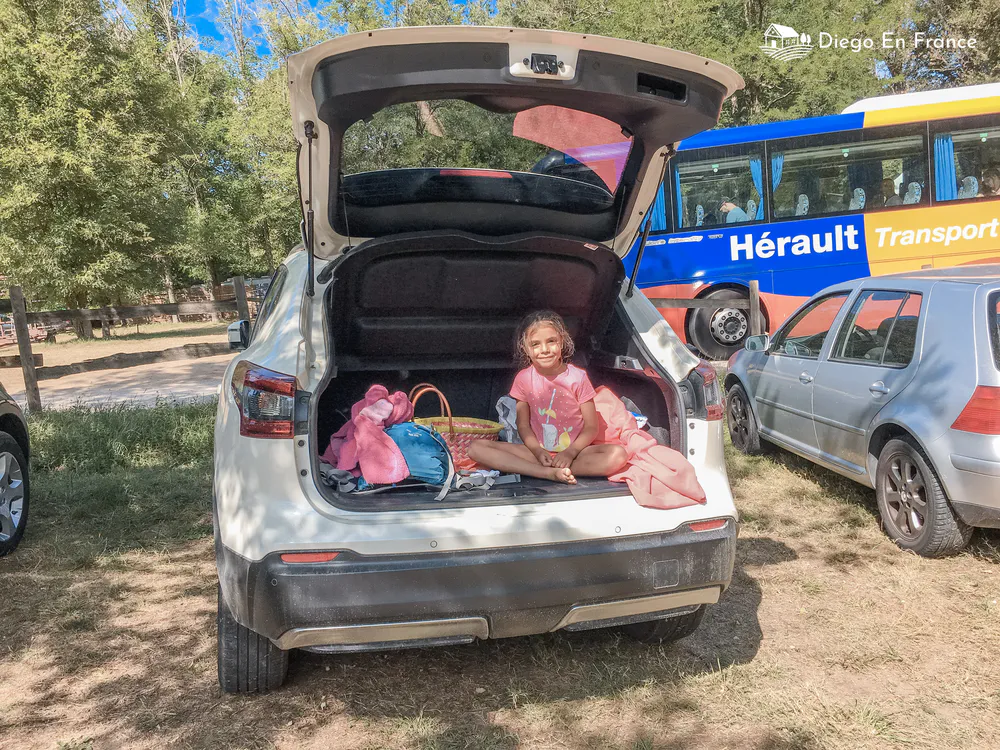
To make driving in France as safe as it is pleasant, it is crucial to become familiar with the peculiarities of driving in this beautiful country.
From specific regulations to local practices on the road, knowing these details can transform a potentially stressful trip into one filled with enjoyment and peace of mind.
👉 Read my guide on why you should visit France as a tourist
Benefits of Traveling by Car in France with Your Family
Once in France, traveling by car has become the preferred option for many. Not only for the convenience it provides, but also for the freedom it gives to marvel at picturesque landscapes and make impromptu stops.
Moreover, as you journey through the charming French roads, what better company than a good playlist? Precisely, I have a very special one that I have prepared for you later on.
What license do I need to drive in France as a tourist?

The first question we ask ourselves when planning our trip to France is whether my license will be useful for driving in France or renting a car.
It is clear that if we want to avoid bad moments in case a Gendarme stops us on the road, it is convenient to be provided with the proper documentation.
To answer this question, it is best to refer to the official information available at www.service-public.fr
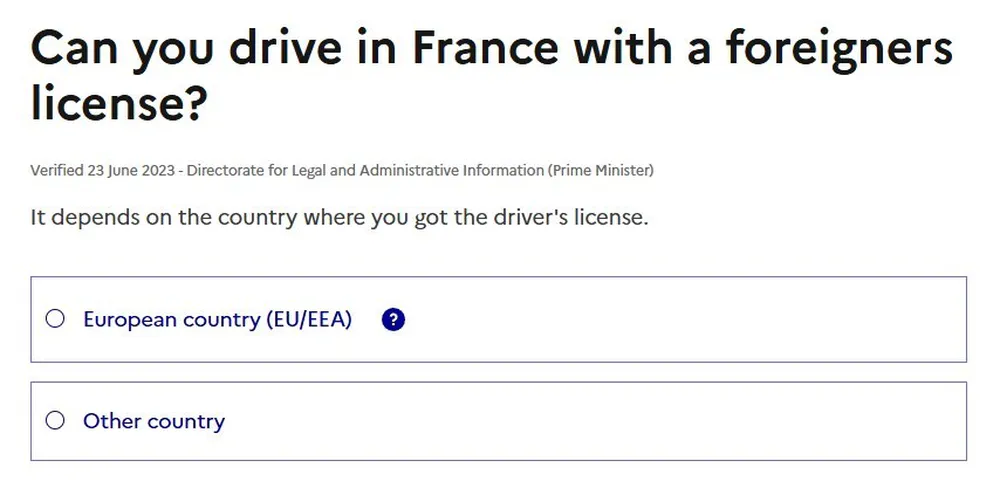
It is then stated that, for short stays :
- If your driving license is issued in an EU country you can bring it with you and use it with complete peace of mind as long as it is within its period of validity.
- If your driving license is issued by a country outside the EU and is valid, it must be written in French or be accompanied by an official translation or an international driving license (unless it is a British license).
It’s as simple as that!
If you need to translate your driving license, according to the specific page of www.service-public.fr , you can consult the list of certified translators at the French consulate of your country of origin and it must then be legalized by that consulate.
👉 Discover my guide with the best real tips for tourists in France
Low Emission Zones (ZFE‑m) in France: Which Crit’Air Sticker Do I Need?
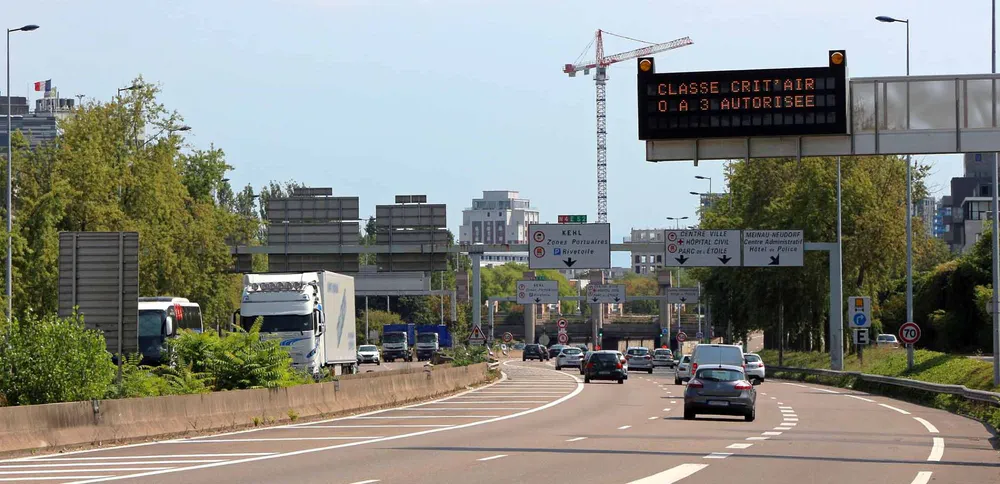
When traveling in France, it is essential to be aware of local regulations in order to drive smoothly, especially in low emission zones (ZFE-m). These areas are designed to reduce air pollution, and some cities have specific requirements for vehicles wishing to enter.
Crit’Air: The required environmental label
The Crit’Air label is a mandatory environmental sticker in some French cities that allows driving in low-emission zones (ZFE-m). It classifies vehicles according to their level of pollutant emissions and helps to reduce air pollution in urban areas.
The Crit’Air sticker is also mandatory for vehicles coming from abroad and must be placed on the vehicle’s windshield. 👉 Access the official step-by-step tutorial here
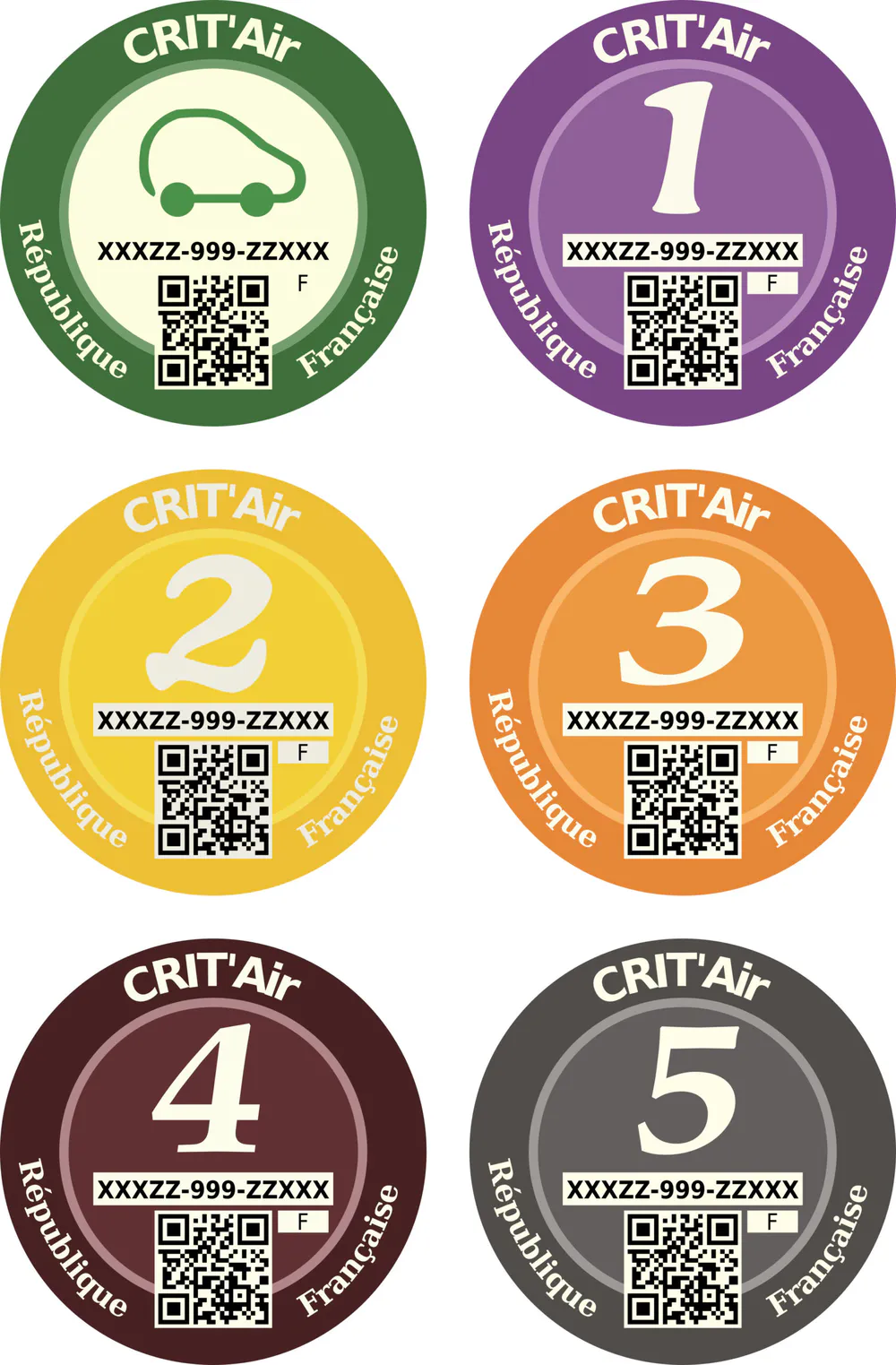
Some of the Low Emission Zones (ZFE-m)
- Ville de Paris and Grand Paris
- Montpellier
- Grand Reims
- Strasbourg
- Toulouse
- Lyon
- Marseille
- Nice-Côte d’Azur
ℹ️ Access here to the official map of the cities and areas where the Crit’Air regulation applies. ZFE-m Map
How do I get the Crit’Air label
1- Access the official website: Visit Crit’Air Certificate, where you can request your label. The site is available in French, English and German.
2- Complete the form: Provide information about your vehicle, including its category and emissions level.
3- Make the payment: The cost of the label is low and can be paid online.
4- Receive the label by mail: It will be sent to the address you indicate, either within France or abroad. Once received, place the label on the windshield of your car..
Diego’s advice :
- Request the label in advance to ensure you receive it on time.
- Bring a digital copy of your application and receipt of payment in case any problems arise during your trip.
With this label you will be able to drive quietly in low-emission zones, enjoying your trip in France without worries.
Rent a car in France and start exploring
The best way to discover the charming villages of France is by car.
Book yours now!
👉 See how to enjoy a restaurant in France with your family
Speed limits in France: highways and roads
Once you have taken care of the driving license issue, the next fundamental aspect when planning your trip to France is to know and respect the maximum allowed speeds.
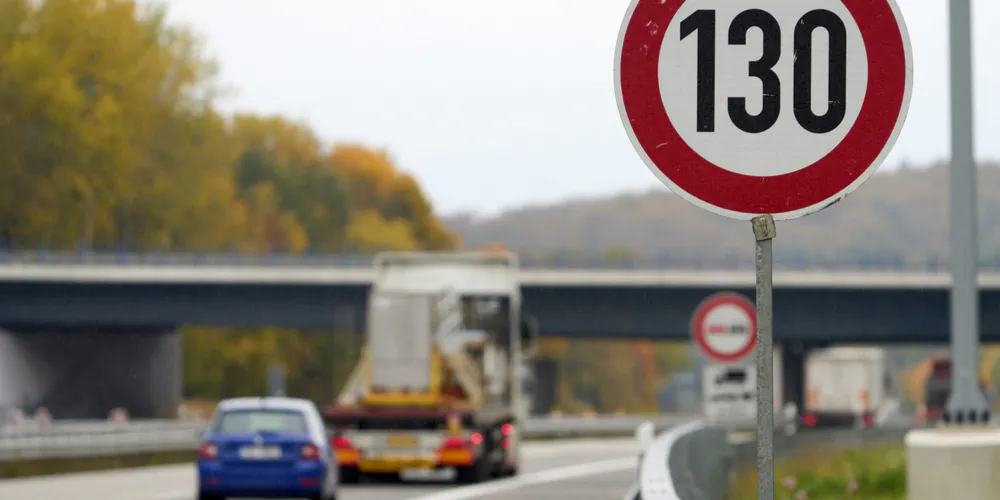
On the highways you will find electronic panels that will inform you of any changes. This is especially true if there is an accident ahead or weather conditions dictate it.
Caution: unlike other countries where the presence of speed cameras is signaled a few kilometers in advance, this is not the case in France. So you must be careful not to exceed the limits in order not to be fined for speeding.
Type of Road | Km / h | Mph |
Highway | 130 | ~80 |
Autoroute | 110 | ~70 |
Secondary roads | 80 - 90 | ~50–55 |
Towns and Cities | 30 | ~20 |
Understanding and adhering to speed limits is crucial not only to avoid fines, but also to ensure the safety of all vehicle occupants and other road users.
Rule: driving on the right and when to overtake in France
An essential driving rule in France, and one that is paramount to maintaining safety on the roads, is the rule of always driving on the right and using the left lane only for overtaking.
This practice is not only regulated by law, but is a crucial part of road etiquette in France, where speeds on freeways and highways can be significantly high.
In addition, it is crucial to remember that overtaking on the right is prohibited and is considered a dangerous practice that can lead to fines and risky situations. Maintaining this driving discipline will not only protect you and your loved ones, but will also contribute to the well-being of all road users.
🚙 Start your unforgettable journey on the French roads. 👉 BOOK YOUR CAR HERE
How to drive correctly in traffic circles in France
The Magic of French Roundabouts
A distinctive and very particular feature of the roads in France is the abundance of traffic circles. You will be surprised when you come across one after another!
Not only do they facilitate the flow of traffic but, in many cases, they are embellished with decorations that reflect the unique character of the town or region where they are located.
I have seen traffic circles with bull statues, little trains coming out of tunnels and even a giant swan!
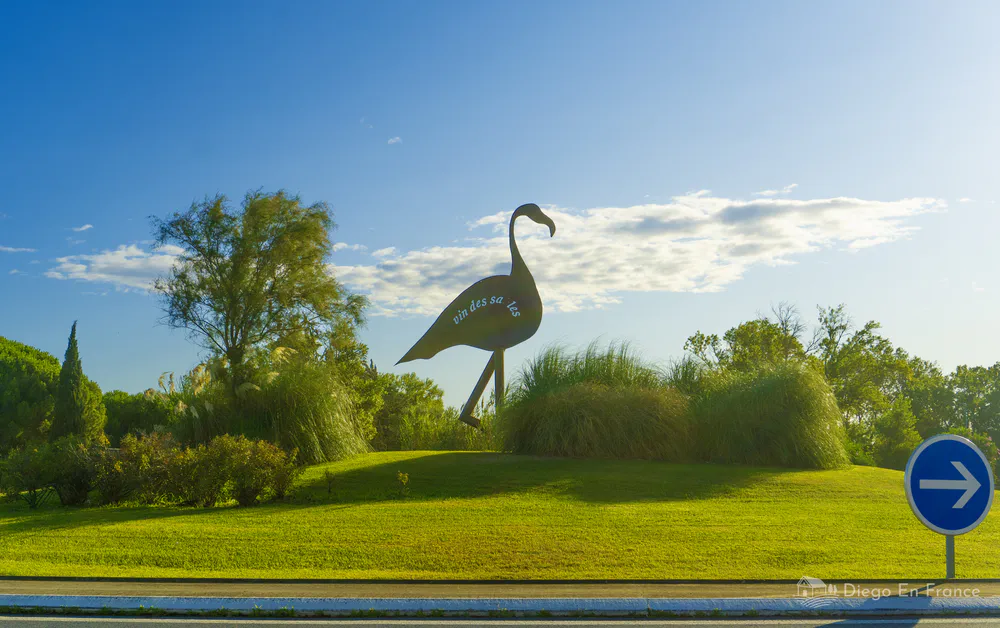
Did you know that France has more roundabouts than any other country in the world?
If you’re planning to drive in France, you need to know this: roundabouts are everywhere!
France leads the global ranking with 42,986 roundabouts across its territory. That’s 65% more than in the United Kingdom, which holds second place.
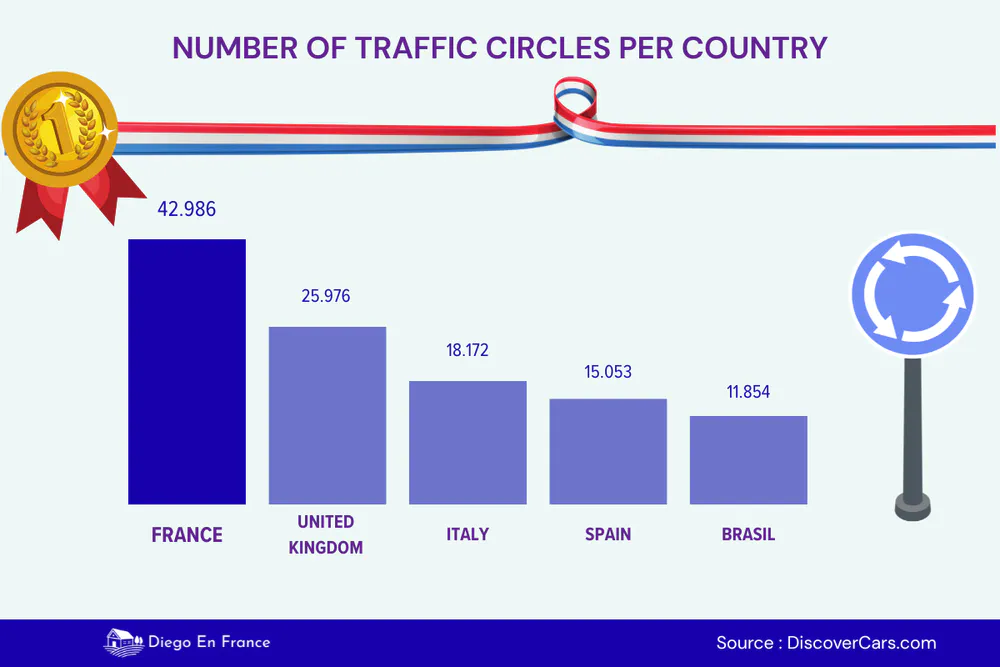
This impressive number of roundabouts reflects not just an urban planning choice, but a very French way of organizing traffic: smoother, safer, and more elegant.
If you’re setting off on a road trip, you’ll encounter plenty of them. And each one could be the start of a new surprise on your route.
Driving in France also means letting yourself be surprised at every roundabout!
Priority and Safety at Roundabouts
For drivers, especially those unfamiliar with this very common feature of French road infrastructure, understanding who has priority when entering and exiting traffic circles is critical to their safety and the flow of traffic.
This means that, when approaching a traffic circle, you must yield to vehicles already moving through the traffic circle.
This standard is essential to prevent congestion and, above all, accidents, while facilitating continuous and safe movement.
Beauty in the Detail: Decorated Roundabouts
Decorated traffic circles offer additional visual appeal during your trip, but they also require your attention and respect for traffic rules.
By navigating these intersections in a safe and considerate manner, you contribute to a more enjoyable and safer driving experience, both for you and your family, as well as for other drivers and pedestrians on France’s lovely roads.
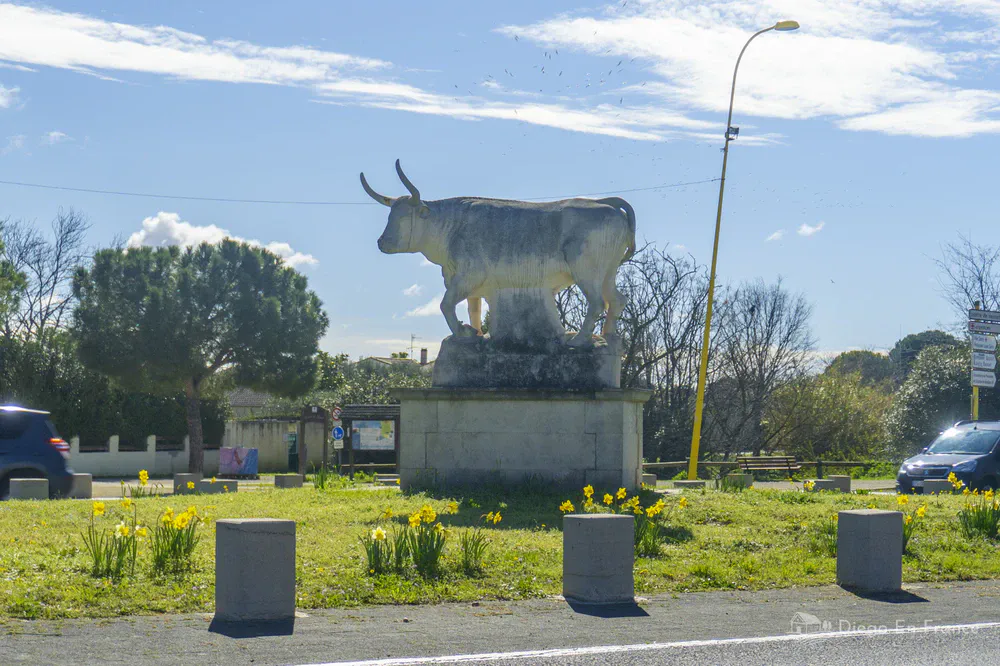
What is the driving side in France?
For those who are planning to come to France and drive on its roads, it is essential to remember that the steering wheel is on the left side in vehicles.
This arrangement, common in most European countries, may require a period of adaptation for drivers from countries where the steering wheel is on the right side.
Familiarizing yourself with this setup before embarking on long road trips will significantly improve your comfort and safety behind the wheel.
Make sure to take a moment to adjust to this arrangement and practice if necessary, especially if it’s your first experience driving a vehicle with the steering wheel on the left side.
Achieve maximum immersion
in French culture
Here’s a playlist to listen to while driving these routes
Travel with Peace of Mind Explore France Without Worries
Unexpected events happen: a medical emergency, lost luggage, or a canceled flight can ruin your adventure. Can you imagine having to pay thousands of euros for a medical consultation?
With IATI INSURANCE, you travel with the best coverage, 24/7 assistance and worry-free.
Don’t wait any longer, protect your trip today.
👉 Make the most of your trip with these local stores and stores
Discovering France by Car on Scenic Backroads
The road network in France will take you to any destination you wish to reach. It is very well developed and in excellent condition.
I recommend, whenever you can, to do stretches on the secondary road network, which will allow you to cross small and charming villages that often you do not expect, bridges, tunnels, rivers and many other unexpected moments.
You will be able to make spontaneous stops, for example in a bulangerie to buy bread or something typical to eat while traveling, or in a cafeteria to have a drink and breathe the authenticity of life in small French villages, among many other surprises that the journey will bring you.
🚙 Start your unforgettable journey on the French roads. 👉 BOOK YOUR CAR HERE
How to avoid traffic jams in France?
When planning your road trip in France, a crucial stop in your planning should be the traffic forecasting website
Accessing the official site of Highways in France is key to anticipate possible traffic jams, especially if your route includes stretches of freeway.
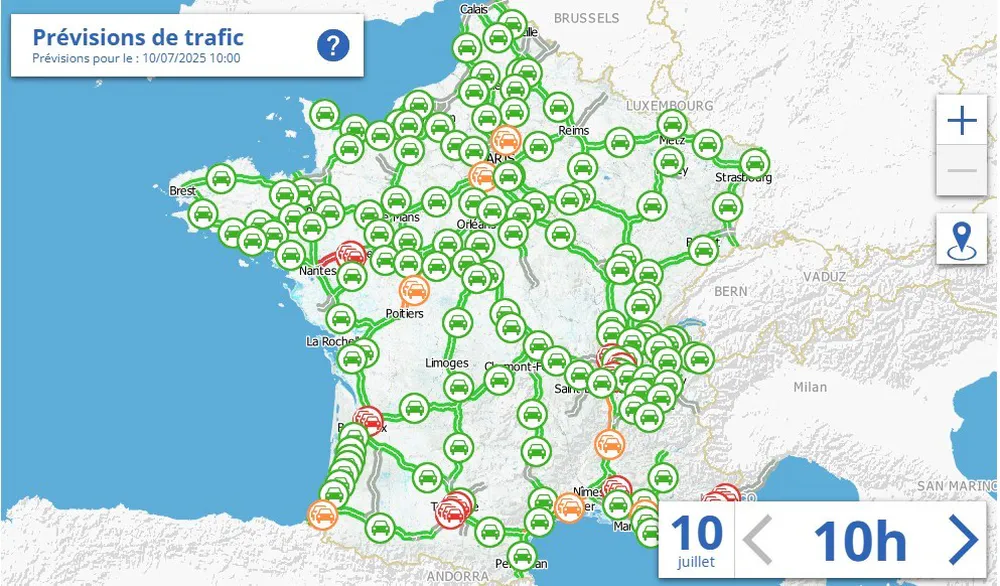
This useful tool that I always consult gives you a preview of traffic flow, allowing you to adjust your travel schedule or route to avoid frustrating delays.
Are there times when it is not advisable to take the car in France?
A very wise decision is to avoid driving during the weekends when people switch vacation periods—especially in the summer—since highways often get jammed and travel times can stretch for hours.
Planning your trip to avoid these dates can be the difference between a smooth trip and hours of stop-and-go in the sun.
Check Real-Time Traffic Conditions on French Highways
The Expert Traveler’s Trick: Tune in to FM 107.7
To get real-time traffic updates while driving in France, nothing beats the official highway radio station:
- FM 107.7 broadcasts live traffic reports specific to your region.
- It includes alerts about accidents, traffic jams, weather conditions, and detours.
- You’ll also hear a mix of useful info, music, and news to keep you company on the road.
- It’s a practical way to stay ahead of disruptions and adapt your route on the go.
- Plus, it’s a great chance to tune your ear to French while traveling.
🛣️ Listening to this station helps you drive more calmly, react quickly, and enjoy your road trip across France to the fullest.
The Importance of Being Informed on the Road
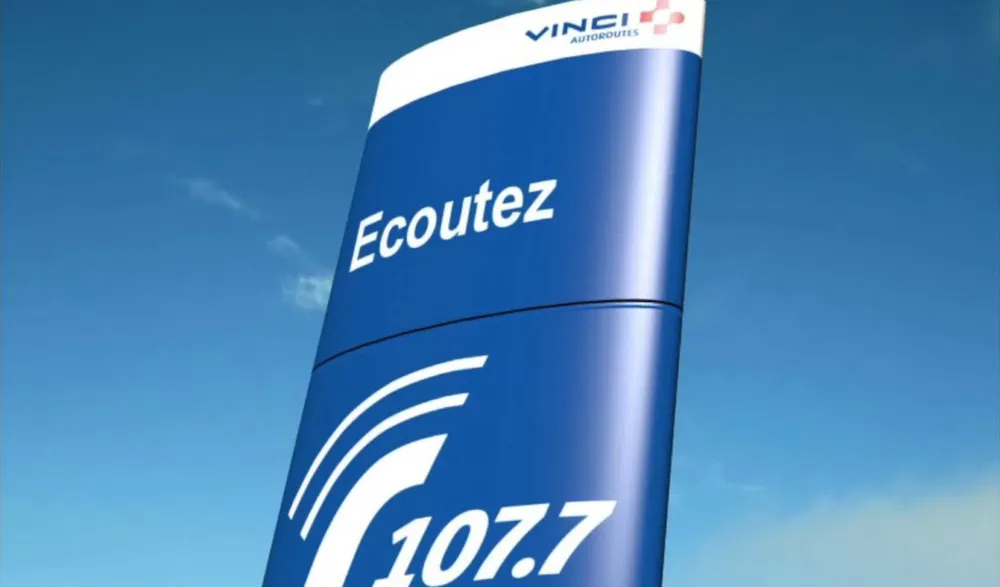
I still remember that trip on the way to Spain, some years ago, thanks to the real time traffic reports, we learned that the border was totally blocked by a big fire. That information was key to get off the highway in time and modify our itinerary.
Although we took a longer route, it was much better than spending the night stuck in the car, waiting for the situation to be resolved. It was a stark reminder that, on the road, being informed is not only convenient, but essential.
👉 See how to enjoy a restaurant in France with your family
Traffic Signs in France: Colors and Meanings
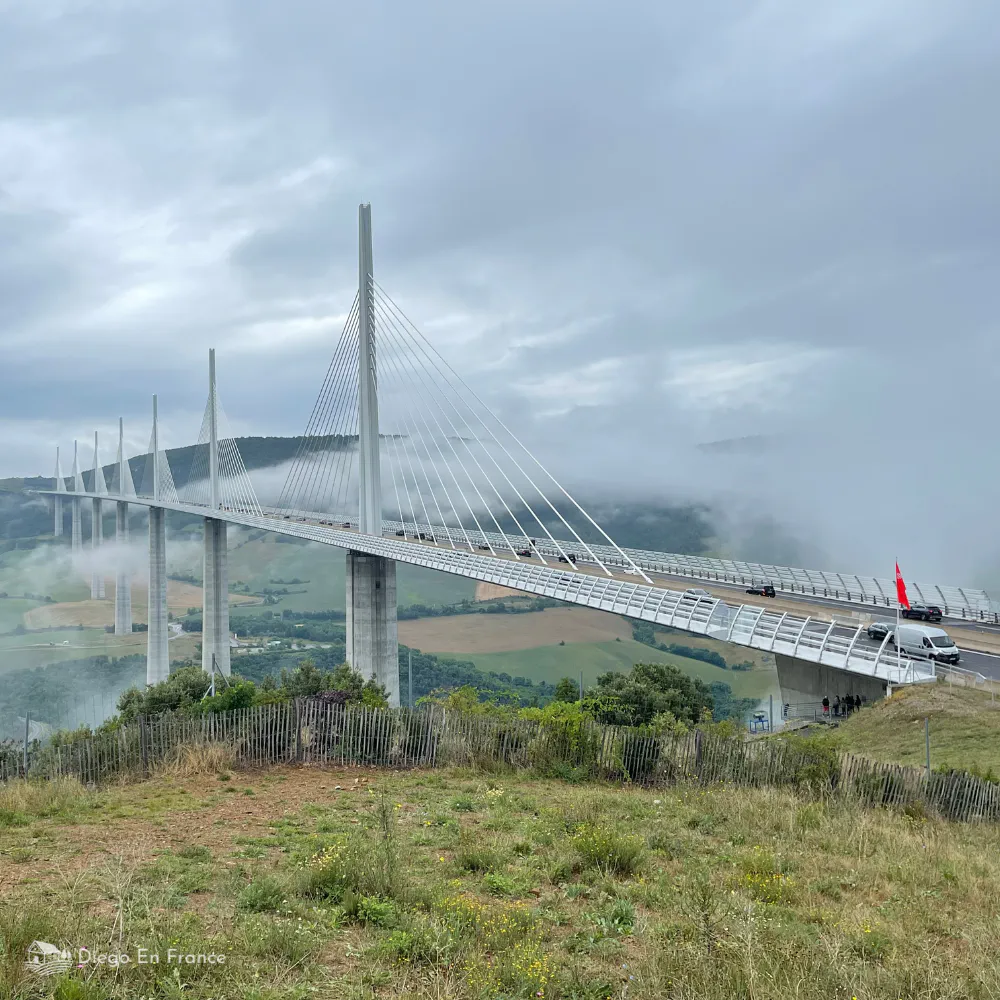
Highways and Efficiency: The Blue Panels
One key feature to keep in mind when driving in France is the color of the signs: blue signs indicate you’re heading toward a highway.
These signs are your best allies for finding the fastest routes between cities and regions, offering the efficiency of high-speed roads.
National and Departmental Highways: The White Panels
White signs, on the other hand, guide you toward national or departmental roads.
These routes invite you to take a slower, more contemplative journey—perfect for those looking to explore landscapes, villages, and towns in greater detail.
Each type of signage prepares you for the driving experience ahead, whether it’s an efficient highway trip or a scenic adventure on less traveled, slower roads.
Highways in France: Speed, Efficiency, and Service Areas
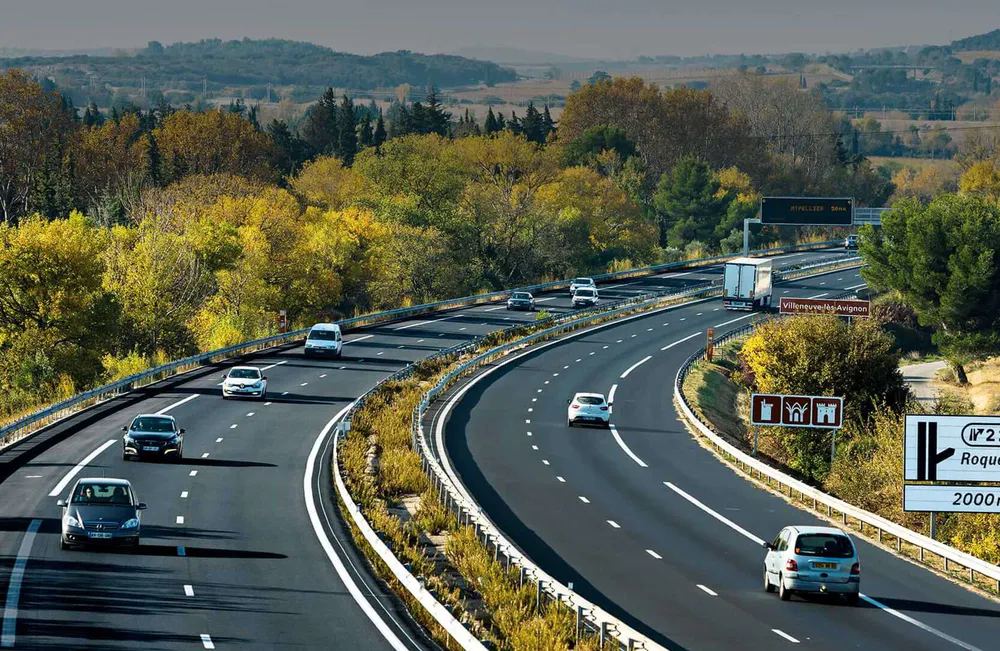
The French highway network is one of the most extensive in Europe, stretching 9,328.1 kilometers and offering a superior travel experience.
It is perfectly developed and provides well-equipped rest areas with excellent infrastructure.
Thanks to it you can get closer to any destination. It is an excellent option to choose for journeys where you want to get there faster.
👉 Read my complete guide to healthy snacks and meal ideas for kids in France.
Tolls in France: Rates, Payment Options, and Télépéage
Maintaining France’s extensive network of highways in optimal condition is a considerable task that involves significant costs. This is why you will encounter numerous tolls along your journey. Familiarizing yourself with the toll system will not only make your trip easier but will also help you better manage your time and budget.
Toll Payment Options: Find Your Best Option
In France, tolls can be paid in several ways: in cash, using machines that accept physical cash, by credit or debit card, or through the Electronic Toll Collection system.
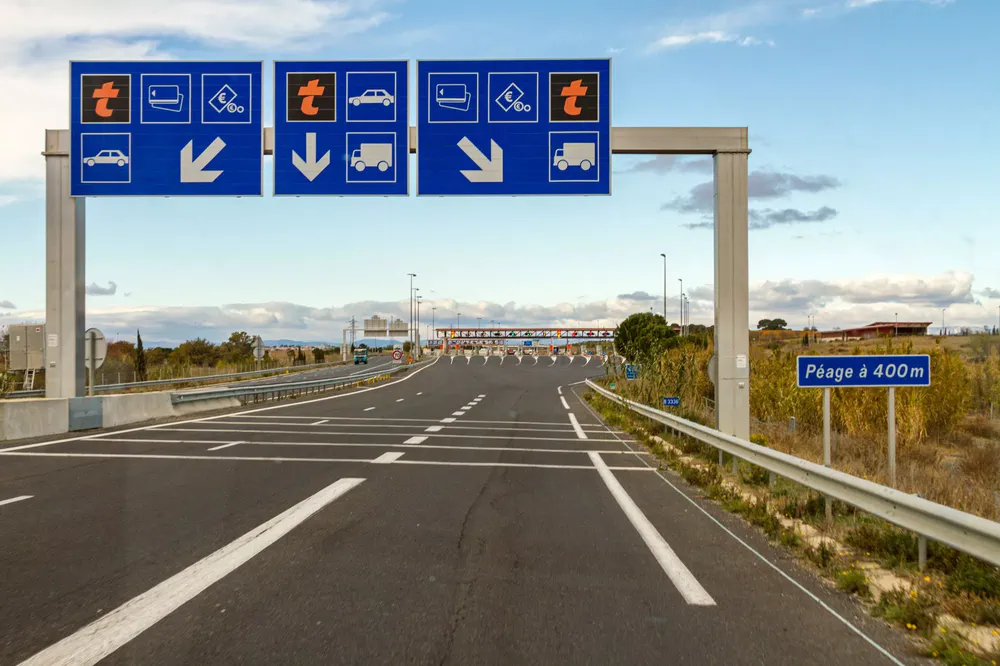
How is the electronic toll system on French highways?
The latter is a method that works through a device placed on the windshield of the car, allowing you to pass through the tolls without stopping, ideal for those seeking to optimize their travel times.
Exclusive ETC lanes are generally located at the ends of toll booths and are identified by orange signs that read “Réservé t“or with a “t“.
Planning in advance which toll payment method best suits your needs will allow you to enjoy a smoother and stress-free driving experience on French highways.
Rest and Recharge: Driving Rest Areas in France
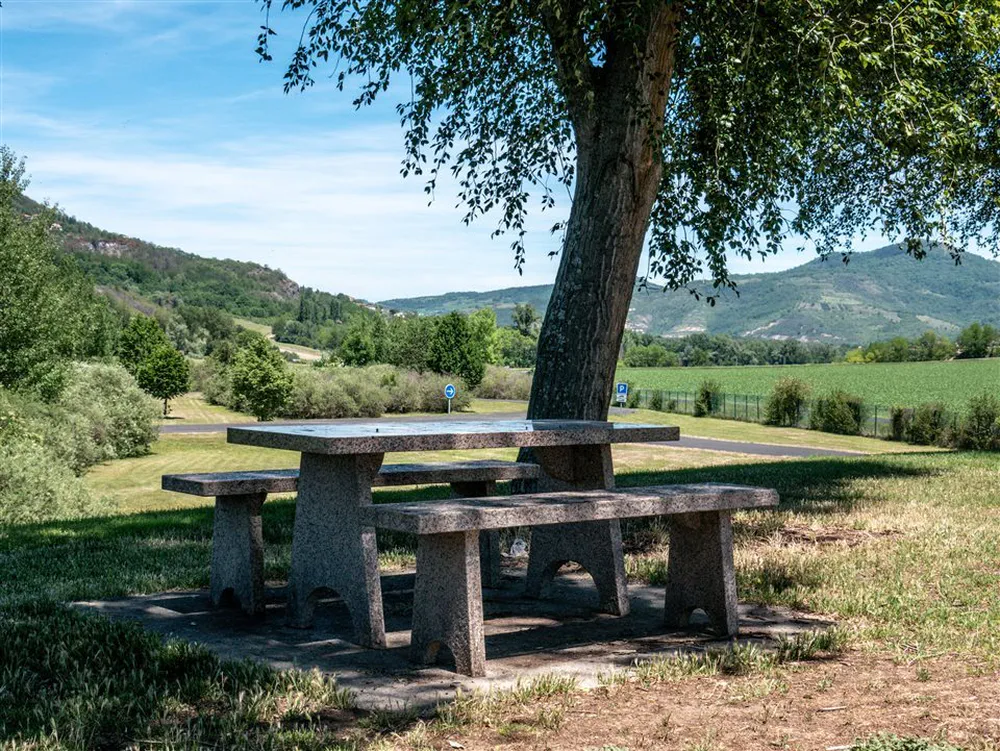
Driving in France offers a unique experience—not only because of its picturesque landscapes and rich culture, but also thanks to the excellent infrastructure of its highways.
One of the features I truly appreciate and absolutely love are the rest and service areas, strategically located approximately every 15 kilometers along the highways.
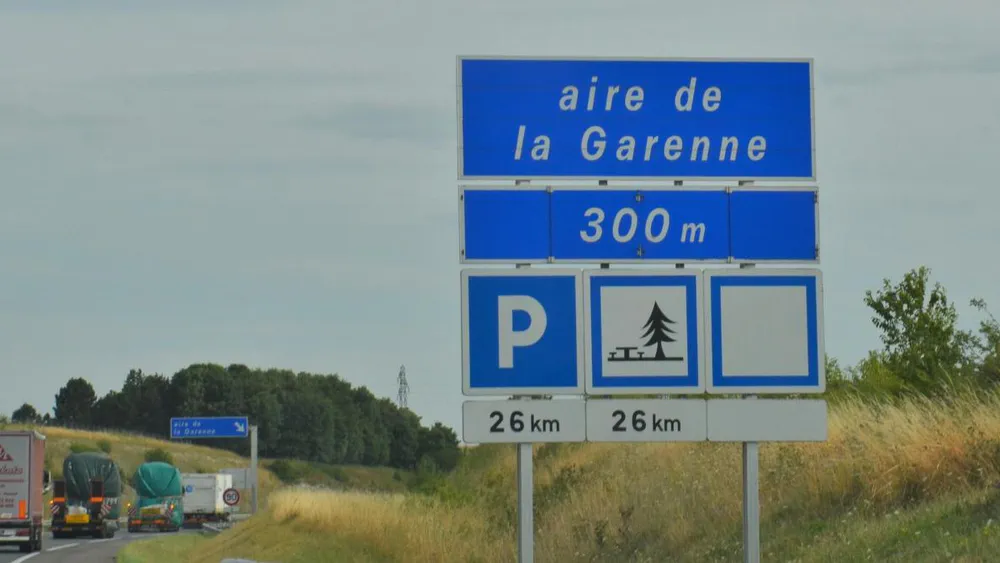
These areas are designed to give you the perfect opportunity to take a break, stretch your legs, let the kids run around a bit, making your trip as enjoyable as the destination you are heading to.
Source: ASFA (Association des Sociétés Françaises d’Autoroutes et d’Ouvrages à Péage)
The Importance of Regular Breaks
The importance of taking regular breaks during a long road trip cannot be underestimated, especially when you are behind the wheel.
Experts recommend stopping at least every two hours of driving to avoid fatigue and stay alert on the road.
These breaks are crucial for the safety and well-being of both the driver and passengers.
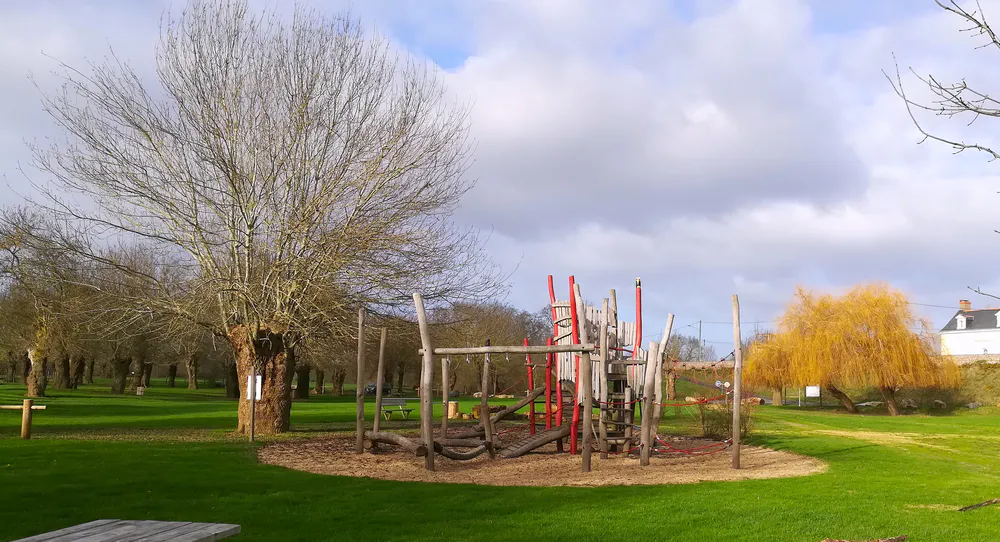
Rest Area Services
Rest areas on French highways are well-equipped to meet the needs of travelers.
You’ll find not only essential services like clean restrooms, but also picnic tables, wide green spaces, and even playgrounds for children.
These spaces are designed to help you relax and enjoy a well-deserved break.
Sometimes we take advantage of them to have a picnic or a snack, also to play with our daughter or just to breathe fresh air and admire the scenery for a while.
Making the Most of Rest Areas
These facilities make driving in France a less exhausting and more enjoyable experience.
Whether you’re crossing the country or exploring a local region, rest areas allow you to recharge, enjoy a moment of calm, and get ready for the next leg of your journey.
Taking advantage of these stops not only boosts your safety and comfort, but also gives you the chance to better appreciate the beauty and diversity of France from its roads.
🚙 Start your unforgettable journey on the French roads. 👉 BOOK YOUR CAR HERE
Driving Service Areas in France
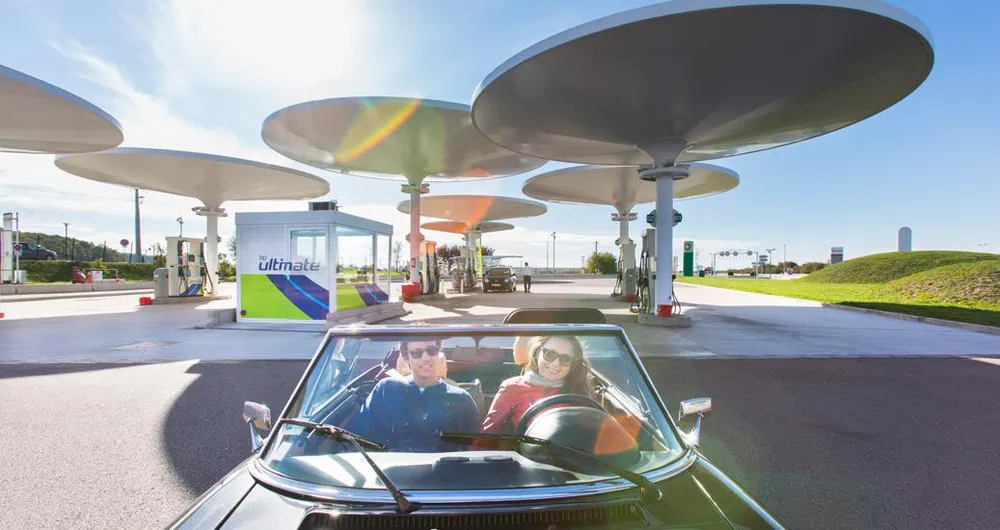
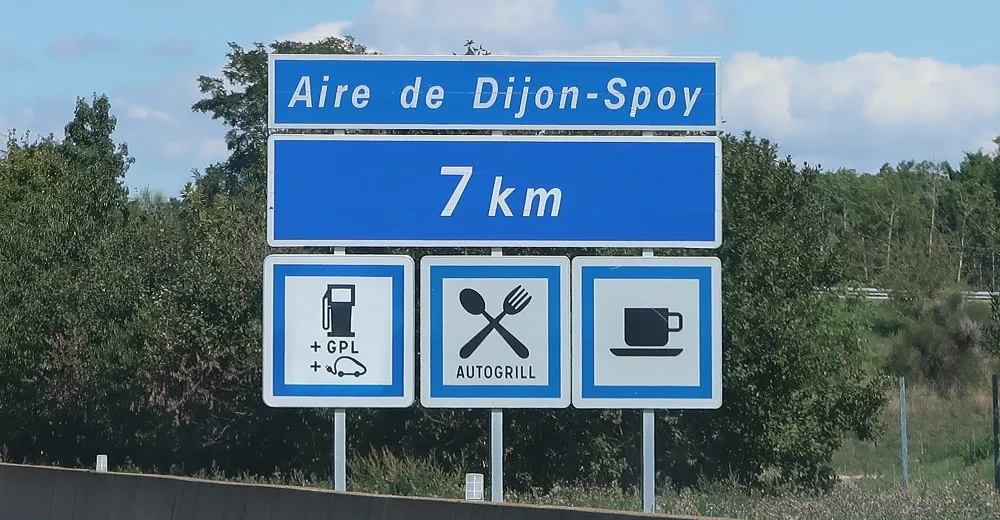
When driving in France, one of the great advantages that complement the travel experience, and are truly spectacular, are the service areas available along the highways. I love them!
In these true oases, besides, of course, being able to charge fuel or car batteries, you can also charge your own!
Source: ASFA (Association des Sociétés Françaises d’Autoroutes et d’Ouvrages à Péage)
More than just Fuel: A Complete Stopping Point
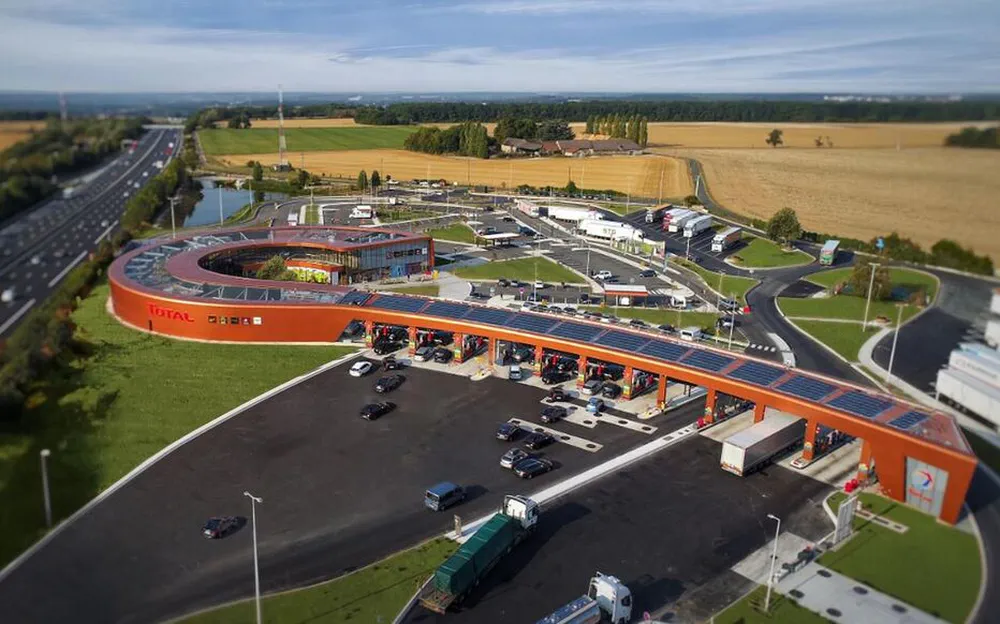
Service areas in France are noted for their wide range of modern and practical amenities, ensuring that travelers have a comfortable and carefree stopover.
With modern toilets in excellent condition, souvenir stores, and convenience stores, travelers can stock up on everything they need for their trip.

These modern and well-equipped areas are designed to offer much more than just a fuel stop.
Here, you’ll have the chance to enjoy large green spaces with picnic tables, playgrounds for kids, and spotless, spacious restrooms (with hand dryers that actually dry your hands).
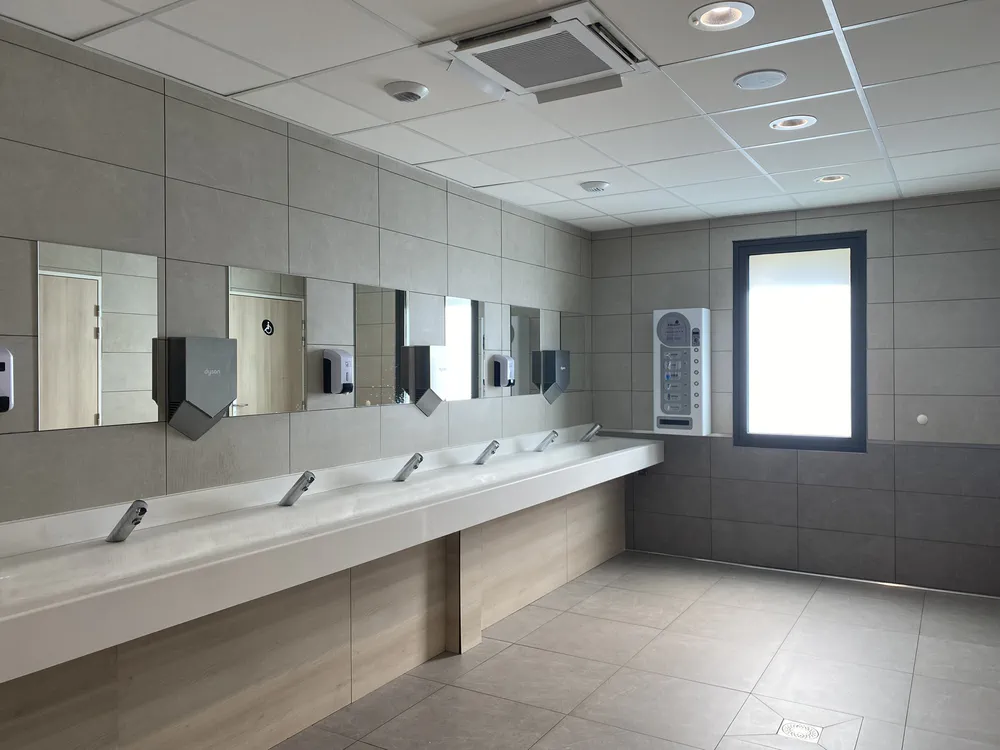
In addition, the gastronomic offer is varied, with restaurants, cafeterias, and fast food chains that satisfy all tastes. For those on longer trips, there are also hotels of well-known chains, making these areas an ideal resting point.
Discover a very special service area in the South of France
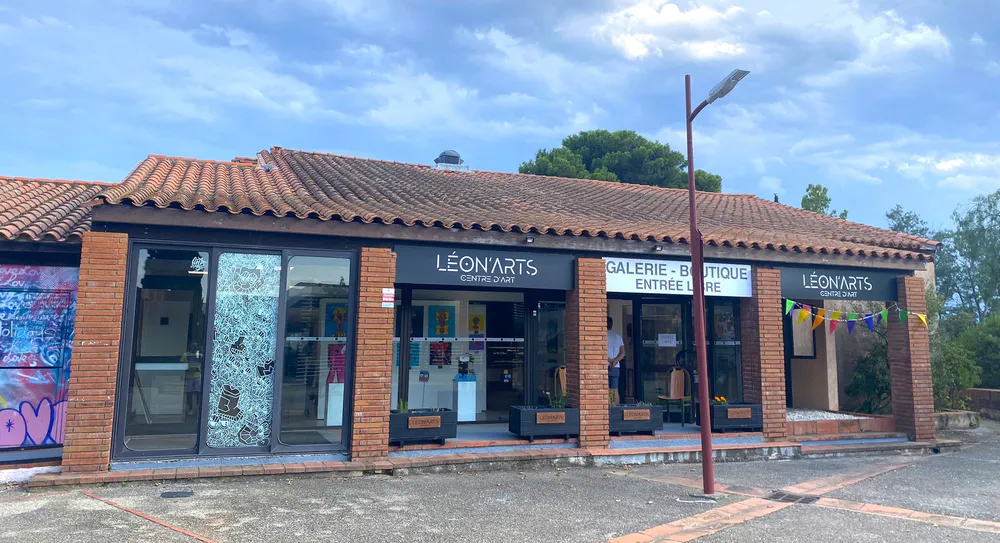
When traveling from Spain on the AP7 (AP-9 in France), you will come across a truly special service area: Village Catalan. This is the first service area you will encounter when crossing the border, and it is known for being super complete, modern and comfortable.
At Village Catalan, you can not only rest and recharge, but also enjoy a unique experience: this rest area features an art gallery housed in a former café, where you can admire works by local artists while taking a break from your journey.
It’s the perfect spot for art lovers and for those looking for more than just a typical roadside stop.
But that’s not all. If you plan to stay a little longer, both you and your children can participate in a short art atelier. These workshops are perfect for stimulating creativity and having a fun family time. It’s an excellent opportunity for the little ones to be entertained and learn something new while enjoying their stop.
ℹ️ Click here to see the art gallery’s agenda
Traveling by Electric Car in France: Charging and Planning
🌿 France is a friendly country to travel with an electric car according to diegoenfrance.com
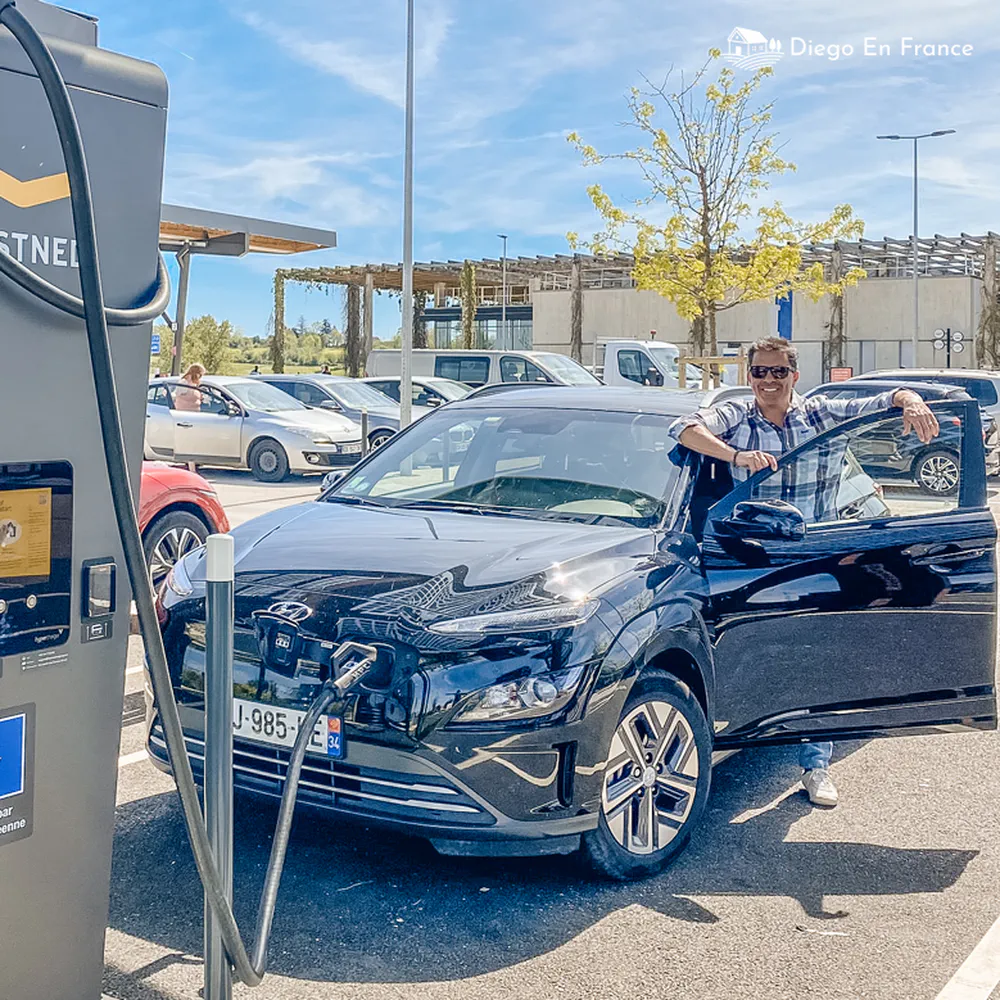
Driving an electric car in France is a great option, as the country has a very well-developed charging station network.
As of the end of Q1 2024, France has 163,656 public charging points, according to Enedis, which provides key figures on electric mobility every quarter.
Moreover, the French government aims to reach 400,000 publicly accessible charging points by 2030.
Map of recharging stations

To plan your trip with an electric car and easily find the charging stations available in France, I invite you to visit the following map: Map of charging stations in France. This resource will allow you to locate the recharging points on your route and ensure you always have access to power for your electric car.
Availability in towns and service areas
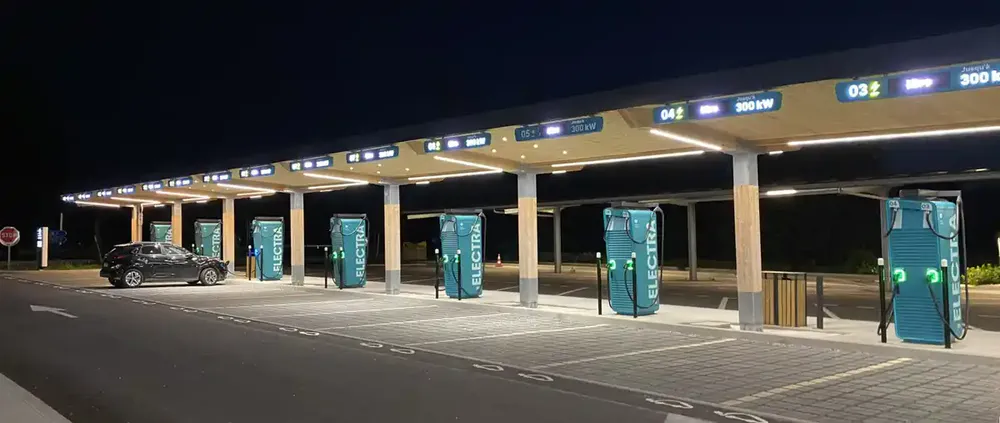
Charging stations aren’t just found in major cities—you’ll also come across them in villages and at most gas stations and service areas.
This gives you peace of mind and makes recharging your EV incredibly easy during your trip through France — no need to leave your route or go out of your way.
While your car is charging, you can enjoy the amenities at these areas, making the experience both convenient and pleasant.
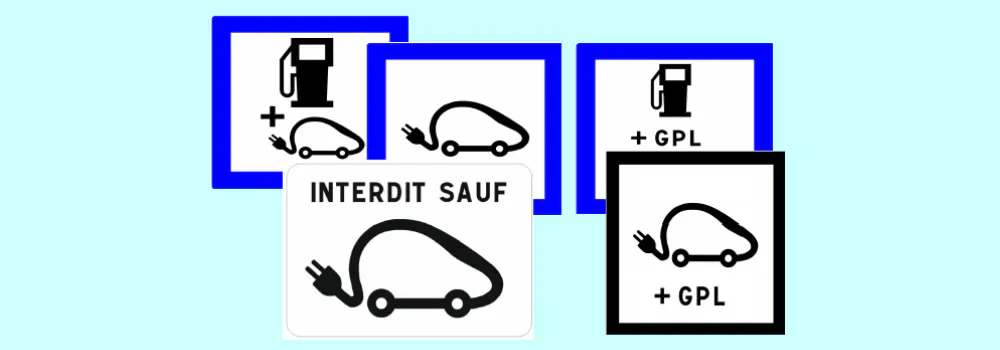
With this well-developed infrastructure, traveling with an electric car in France is a simple and pleasant experience. Enjoy the road with the peace of mind of knowing that you will always have a recharging point nearby!
Take a break with a difference: discover the Villages Étapes
If you’re planning a road trip through France, don’t limit yourself to the typical highway rest areas. Along the country’s national roads (routes nationales), there’s a more charming option waiting for you — the Villages Étapes. These are small, welcoming towns scattered across France, perfect for a relaxing and authentic travel break. Today, there are 78 Villages Étapes officially recognized for offering top-notch services to travelers.
What Exactly is a Village Étape? A Village Étape is a small town (fewer than 5,000 residents) that meets strict criteria to ensure a comfortable stop for road trippers:
- Located less than 5 km or 5 minutes from a main road
- Offers delicious local cuisine
- Features quality accommodation with easy parking
- Includes all essential services: bakery, pharmacy, market, café
- Beautifully maintained, flower-filled towns with a lively center and a tourist office

Taking a break in one of these towns is more than just stretching your legs — it’s an opportunity to experience authentic, off-the-beaten-path France, far from the crowds and full of charm.
ℹ️ Want to plan your next stop? Check the official website to see all Village Étape locations across France.
Basic Vocabulary : Key Terms for Driving in France
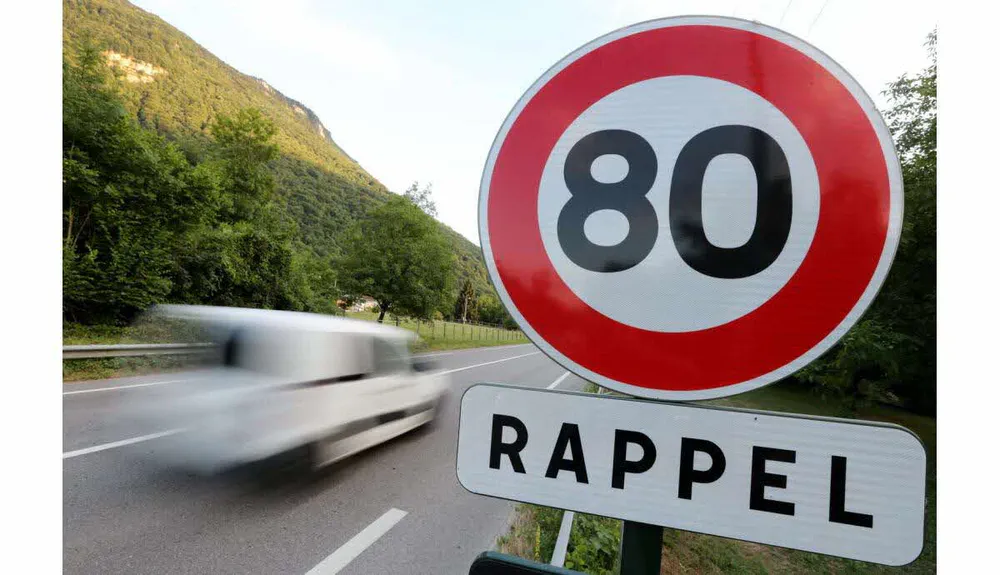
As you embark on the adventure of driving along the scenic roads of France, knowing a few key French words and phrases can be very helpful.
Droite >> | Right | Rond Point >> | Traffic Circle |
Gauche >> | Left | Aire de répos >> | Rest Area |
Rappel >> | Remember | Aire de service >> | Service Area |
Vitesse >> | Speed | Payant >> | Paying |
Ralentir >> | Slow Down |
This knowledge will not only allow you to follow road signs more easily, but will also give you more confidence. Here are some useful words and phrases that will help you get around France more easily, making your trip even more enjoyable and safe.
Learn French with the Same Method Used by Diego en France
Learn French the Fun Way – My Favorite Method!
It’s super fun, totally intuitive, and the best part? You get the first week FREE — just to try it out!

Frequently Asked Questions About Driving in France
Do I need an international driving permit to drive in France?
It depends on where your license was issued. If it’s from the European Union, you can drive in France without any issues. If it’s from outside the EU, you’ll need an official translation or an international driving permit.
Is it hard to drive in France if I don’t speak French?
No. Road signs are clear, icons are universal, and many apps like GPS or Google Maps will assist you in your own language. Still, knowing a few key words can be helpful.
What’s the speed limit when driving in France?
On highways, the general speed limit is 130 km/h, but it drops to 110 km/h in rainy conditions. On secondary roads, it’s usually 80 or 90 km/h.
Is it a good idea to rent a car for a family road trip in France?
Yes, it’s an excellent way to discover villages, landscapes, and regions that aren’t well connected by train. Plus, you can adapt your stops to your kids’ rhythm.
Conclusion: Enriching Your Road Trip in France
Driving in France is more than just an act of moving from one point to another; it is an adventure in itself, full of discovery, comfort and memorable experiences.
From scenic back roads to efficient highways, every kilometer traveled invites you to immerse yourself in the rich culture and beautiful French landscape.
The rest and service areas, with their ample facilities, not only guarantee your safety and well-being, but also enhance the pleasure of your trip, allowing you to fully enjoy what France has to offer.
Whether you stop to admire an artistically decorated traffic circle, take a well-deserved break in a green area, or enjoy a local meal at a service area, every stop is an opportunity to enrich your travel experience.
The tips and recommendations shared here are designed to help you navigate the French roads with ease and confidence, transforming your trip into a collection of precious and unforgettable memories.
So, when you find yourself driving in France, remember that the journey is as significant as the destination. With the right preparation and an open mind, you’ll be ready to make the most of what this beautiful country has to offer, making every moment on the road an integral part of your French adventure.
Newsletter Diego en France
Subscribe
No Spam. I send a maximum of 3 newsletters per month with the latest news about Diego in France.



Thank you Diego for this woderfully written and informative site. My partner and I (we are both in our early 80’s) would love to do some driving around France in Ocotober. How busy are the roads tyrpically at that time of year? Ideally we would be using National and Departmental roads rather than the freeways. We are particualrly interested in visiting the old province of Franche-Comte (my mother’s home) and Normandy.
Would very much appreciate your evaluation of these plans!
Merci!